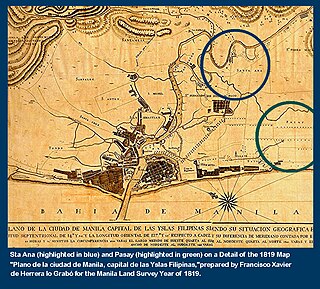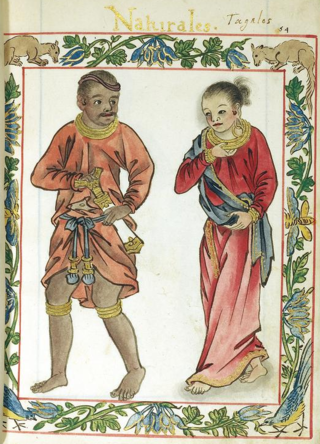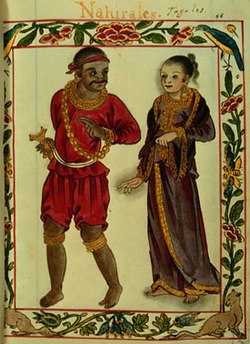Present-day usage
In present-day culture, the term is still occasionally used to mean "nobleman", but has mostly been adapted to other uses.
The name of Malacañan Palace, the official residence of the president of the Republic of the Philippines, is traditionally attributed to the phrase may lakan diyan, or "the king [or head] resides there". [7]
In Filipino Martial Arts, lakan denotes an equivalent to the black belt rank. [8] Also, beauty contests in the Philippines have taken to referring to the winner as "lakambini", the female equivalent of lakan. In such cases, the contestant's assigned escort can be referred to as a lakan. More often, a male pageant winner is named a lakan. [9]
Philippine National Police Academy graduates are called lakan (male) and lakambini (female)

Sulayman, sometimes referred to as Sulayman III, was a Crown Prince of the Kingdom of Luzon in the 16th century and was a nephew of King Ache of Luzon. He was the commander of Luzonian forces in the battle of Manila of 1570 against Spanish forces.

Islam in the Philippines is the second largest religion in the country, and the faith was the first-recorded monotheistic religion in the Philippines. Historically, Islam reached the Philippine archipelago in the 14th century, through contact with Muslim Malay and Arab merchants along Southeast Asian trade networks, in addition to Yemeni missionaries from the tribe of Alawi of Yemen from the Persian Gulf, southern India, and their followers from several sultanates in the wider Malay Archipelago. The first missionaries then followed in the late 14th and early 15th centuries. They facilitated the formation of sultanates and conquests in mainland Mindanao and Sulu. Those who converted to Islam came to be known as the Moros, with Muslim conquest reaching as far as Tondo that was later supplanted by Bruneian Empire vassal-state of Maynila.
Lakandula was the title of the last lakan or paramount ruler of pre-colonial Tondo when the Spaniards first conquered the lands of the Pasig River delta in the Philippines in the 1570s.

Datu is a title which denotes the rulers of numerous Indigenous peoples throughout the Philippine archipelago. The title is still used today, though not as much as early Philippine history. It is a cognate of ratu in several other Austronesian languages.

In early Philippine history, the Tagalog settlement at Tondo, sometimes referred to as the Kingdom of Tondo, was a major trade hub located on the northern part of the Pasig River delta, on Luzon island. Together with Maynila, the polity (bayan) that was also situated on the southern part of the Pasig River delta, had established a shared monopoly on the trade of Chinese goods throughout the rest of the Philippine archipelago, making it an established force in trade throughout Southeast Asia and East Asia.

Namayan, also called Sapa, Maysapan, and sometimes Lamayan, was an independent indigenous polity on the banks of the Pasig River in the Philippines. It is believed to have achieved its peak in 1175, and to have gone into decline sometime in the 13th century, although it continued to be inhabited until the arrival of European colonizers in the 1570s.

Akí, also known as Rája Matandâ, was King of Luzon who ruled from the kingdom's capital Manila, now the capital of the Republic of the Philippines.

In Philippine history, the Tagalog bayan of Maynila was one of the most cosmopolitan of the early historic settlements on the Philippine archipelago. Fortified with a wooden palisade which was appropriate for the predominant battle tactics of its time, it lay on the southern part of the Pasig River delta, where the district of Intramuros in Manila currently stands, and across the river from the separately-led Tondo polity.

The recorded history of the Philippines between 900 and 1565 begins with the creation of the Laguna Copperplate Inscription in 900 and ends with the beginning of Spanish colonization in 1565. The inscription records its date of creation in 822 Saka. The discovery of this document marks the end of the prehistory of the Philippines at 900 AD. During this historical time period, the Philippine archipelago was home to numerous kingdoms and sultanates and was a part of the Indosphere and Sinosphere.

In early Philippine history, barangay is the term historically used by scholars to describe the complex sociopolitical units that were the dominant organizational pattern among the various peoples of the Philippine archipelago in the period immediately before the arrival of European colonizers. Academics refer to these settlements using the technical term "polity", but they are usually simply called "barangays".

The 1570 Battle of Manila was fought in Manila between Luzonians, led by Prince Sulayman, and Spaniards, led by field marshal Martin de Goiti, on 24 May 1570. Goiti's forces eventually besieged the fort of Manila, destroyed Manila, and won the battle, with the site of the fort falling to the Kingdom of the Spains and the Indies. The Spaniards then founded a Spanish city of Manila making it the capital of the Spanish East Indies.
Datu Magat Salamat was a Filipino historical figure best known for co-organizing the Tondo Conspiracy of 1587. He was one of at least four sons of Lakandula, and thus held the title of Datu under his cousin and co-conspirator Agustin de Legazpi, who had been proclaimed paramount ruler of the indianized kingdom of Tondo after the death of Lakandula, although the position soon became little more than a courtesy title.
In Philippine folk tradition, Rajah Salalila was the Rajah or paramount ruler of the early Indianized Philippine settlement of Maynila, and the father of the individual named Ache, who would eventually be well known as Rajah Matanda. Based on perceived similarities between the names, he is sometimes also called Sulaiman I in the belief that he shared the name of his supposed grandson, Rajah Sulayman.

Dayang Kalangitan is a legendary figure in early Philippine history who was said to be Dayang of the pre-Hispanic Indianized polity of Pasig. She was co-regent of Pasig with her husband, Rajah Lontok, and later sole ruler of their realms. She is one of the very few known female leaders in precolonial Philippine history.
In the Philippine languages, a system of titles and honorifics was used extensively during the pre-colonial era, mostly by the Tagalogs and Visayans. These were borrowed from the Malay system of honorifics obtained from the Moro peoples of Mindanao, which in turn was based on the Indianized Sanskrit honorifics system and the Chinese's used in areas like Ma-i (Mindoro) and Pangasinan. The titles of historical figures such as Rajah Sulayman, Lakandula and Dayang Kalangitan evidence Indian influence. Malay titles are still used by the royal houses of Sulu, Maguindanao, Maranao and Iranun on the southern Philippine island of Mindanao. However, these are retained on a traditional basis as the 1987 Constitution explicitly reaffirms the abolition of royal and noble titles in the republic.

The term Paramount Ruler, or sometimes Paramount Datu, is a term used by historians to describe the highest ranking political authorities in the largest lowland polities or inter-polity alliance groups in early Philippine history, most notably those in Maynila, Tondo, Pangasinan, Cebu, Bohol, Butuan, Cotabato, and Sulu.
Agustin de Legazpi is a prominent historical figure in the Philippines best known as the leader of the Tondo Conspiracy of 1587–1588, the last native ruler of Tondo, and the last individual to hold the title of paramount ruler in any of the Indianized indigenous Tagalog polities of the Pasig River delta, although it had been reduced to little more than a courtesy title by the time of Agustin de Legazpi's execution. He was a great grandson of the Bruneian Sultan and distant descendant of Caliph Hasan ibn Ali and was a convert from Islam to Christianity, his Bruneian name was Rajah Muhammad Zahir al-Din.
The term "Lakan Dula Documents" is used by Philippine historiographers to describe the section of the Spanish Archives in Manila which are dedicated to the genealogical records of the "Manila aristocracy" from the period immediately following European colonial contact. As of 2001, only one bundle of twelve folders remains in the archive, the rest having been lost, misplaced, or destroyed by various events such as the Japanese Occupation of Manila during World War II. The surviving bundle is labeled "Decendientes de Don Carlos Lacandola", and scholars use the term "Lacandola Documents" as an informal shortcut.









